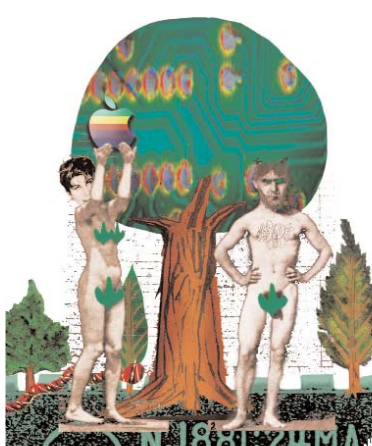"Consuming Passions": Hawaii…
Hawaii has everything: beaches, mountains, golf courses (if you must), palm trees and orchid plantations. It also now has fabulous (literally fabulous as in wild and crazy) food. The state is in a feeding frenzy – call it Hawaiian Regional, call it Pacific R im. This is food with panache, accessible food, as playful as a Blue Hawaii cocktail, flamboyant as a Waikiki sunset, postmodern as a Vegas resort but with references to Asia, France, California, and always Hawaii. The pineapple is now a salsa, the guava a coulis, the macadamia nut in a crab cake. This is the perfect culinary metaphor for the islands: the lush landscape; endless seas; the mixed ancestry of the inhabitants – Asian plantation workers, European entrepreneurs, American missionaries. Until recently, Hawaii was a food hell of stale buffets and “continental” cuisine and fancy but dreadful hotel restaurants; on an island where you could smell the pineapple plantations, hotels served the canned fruit from the mainland. Now it’s in the feverish grip of an evolving cuisine, of celebrity chefs obsessed by local produce. Menus list the provenance of a Waimea tomato as if it were a Vermeer. (At Mama’s Fish House in Maui the menu informs you the “opah is caught in open seas aboard the fishing vessel ‘Jennifer’”.) I love it – the food, the fantastic menus that might have been written by a delirious surfer-chef confronting the big wave. At S ansei restaurant in Honolulu, I eye a Kapalua “Butterfry” roll; fresh snapper, smoked S ake, blue crab, vegetables, flash fried to a crispy crust. I contemplate Spam Musubi (sticky rice and Spam), at $500 a jokey homage to what the locals call Hawaiian Pâté, once a staple of the islands. In the late 1980s, chef Roy Yamaguchi first mixed it up, classical techniques, tropical ingredients. It was seditious stuff. More chefs followed and started cooking up a storm. L ocal suppliers rose to the challenge and mesclun replaced iceberg lettuce. Inevitably, fish is in the front lines. (The state fish is humuhumunukunukuapua’a.) But there is local beef and pork, coffee, chocolate and fruit, and how can I resist the macadamia-coconut crusted lamb chops at Alan Wong’s Honolulu restaurant? Wong is a star of the new Hawaii food; his Asian ancestry, classical training ( Lutèce in New York), laid-back U S style, humour, drive and local ingredients, all go into his cooking. “For years, they said the best food in Hawaii was on the plane over,” he says. “But immigrants – Japanese, Thais, Samoans, Laotians, Koreans – brought food and style. And the Chinese, descendants of labourers who came to work the cane and pineapple plantations, brought the wok.” Out of this come some of Wong’s riffs on childhood dishes: “We grew up eating L oco Moco, white rice, brown beef patty, egg, brown gravy, fried onions. I reinvented it with quail’s egg and foie gras.” Me, I’m nuts about his gussied-up version of Poke, the island Ceviche made by fisherman who cut ahi into rough cubes and cure it with local rock salt. Wong does it as Poki-Pines, ahi won ton balls on avocado. Not to mention Da Bag, an exploding Kilauea of appetisers including succulent Manila clams with Kalua Pig, shiitake mushrooms, spinach, chicken stock and tomatoes. Most of the best food is in Honolulu: at L ’Uraku, Hiroshi Fukui learned his trade in Japan; at Chef Mavro, Hawaii’s current gastro temple, the chef is a Frenchman of Greek descent, whose Keahole lobster comes with asparagus risotto, truffle oil, crustacean coulis. The malasadas (Portuguese doughnuts) are surrounded by guava coulis and pineapple-coconut ice cream. Picnic on a bronzed duck from Honolulu’s Chinatown. Or for the sushi experience of a lifetime, go to Sushi Sasbune. It’s better than sex. The rice is fluffy, the fish lush, firm, velvety and tasting faintly of the sea. The place is a dive, the waiter more acolyte than server. They call the chef, S eiji Kumagawa, the S ushi Nazi. “ Omakase ” (“Trust me”) a sign says. You eat what he feels like making. This is usually the kind of place that makes me order ketchup, but Kumagawa makes sushi to die for: the stuffed blue crab with a fluffy wasabi is exquisite, so are the hamachi and toro, salmon roe, blue crab hand roll, eel and omelette, the uni that the chef calls “ocean ice cream”. Even my companion, who normally thinks sushi is food someone forgot to cook, says, “It’s subtle, coercive, seductive, the platonic ideal of fishness. If some of those fusion places are a gothic novel, then this is a haiku.” ✦
|
 It’s
February, armpit of the year, when a girl’s thoughts turn to
sunshine and maybe a pink parasol in her drink. We’re talking
Hawaii here. We’re talking surfer boys with lean tanned bodies,
endless waves and Technicolor sunsets. America’s improbable 50th
state, a tropical island paradise plopped in the middle of the
Pacific, is a melting pot with an Asian face, wrapped in a white-bread
dream of utopia.
It’s
February, armpit of the year, when a girl’s thoughts turn to
sunshine and maybe a pink parasol in her drink. We’re talking
Hawaii here. We’re talking surfer boys with lean tanned bodies,
endless waves and Technicolor sunsets. America’s improbable 50th
state, a tropical island paradise plopped in the middle of the
Pacific, is a melting pot with an Asian face, wrapped in a white-bread
dream of utopia. 


